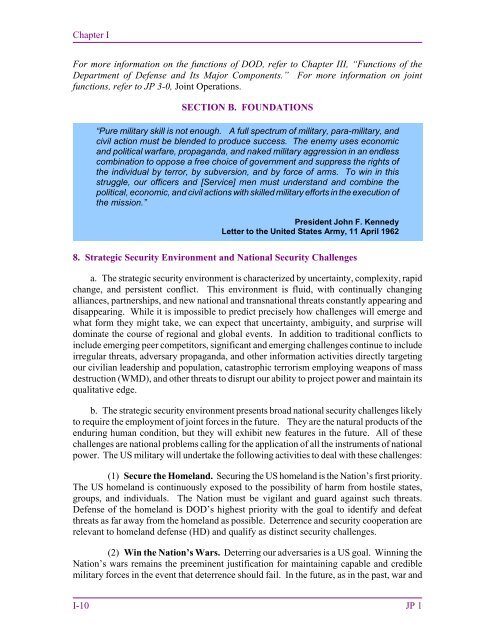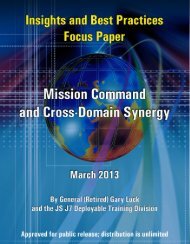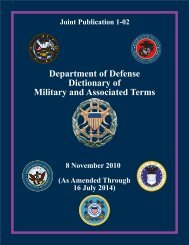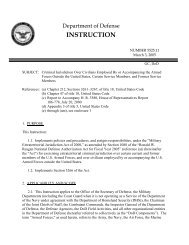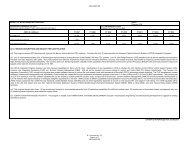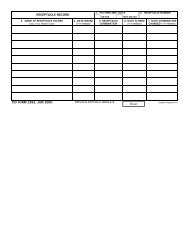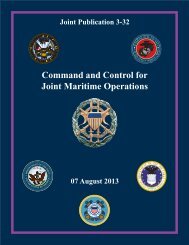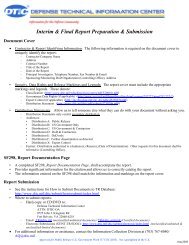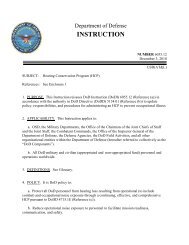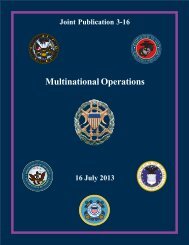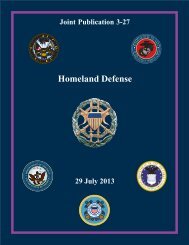JP 1, Doctrine for the Armed Forces of the United States - Defense ...
JP 1, Doctrine for the Armed Forces of the United States - Defense ...
JP 1, Doctrine for the Armed Forces of the United States - Defense ...
You also want an ePaper? Increase the reach of your titles
YUMPU automatically turns print PDFs into web optimized ePapers that Google loves.
Chapter I<br />
For more in<strong>for</strong>mation on <strong>the</strong> functions <strong>of</strong> DOD, refer to Chapter III, “Functions <strong>of</strong> <strong>the</strong><br />
Department <strong>of</strong> <strong>Defense</strong> and Its Major Components.” For more in<strong>for</strong>mation on joint<br />
functions, refer to <strong>JP</strong> 3-0, Joint Operations.<br />
SECTION B. FOUNDATIONS<br />
“Pure military skill is not enough. A full spectrum <strong>of</strong> military, para-military, and<br />
civil action must be blended to produce success. The enemy uses economic<br />
and political warfare, propaganda, and naked military aggression in an endless<br />
combination to oppose a free choice <strong>of</strong> government and suppress <strong>the</strong> rights <strong>of</strong><br />
<strong>the</strong> individual by terror, by subversion, and by <strong>for</strong>ce <strong>of</strong> arms. To win in this<br />
struggle, our <strong>of</strong>ficers and [Service] men must understand and combine <strong>the</strong><br />
political, economic, and civil actions with skilled military ef<strong>for</strong>ts in <strong>the</strong> execution <strong>of</strong><br />
<strong>the</strong> mission.”<br />
President John F. Kennedy<br />
Letter to <strong>the</strong> <strong>United</strong> <strong>States</strong> Army, 11 April 1962<br />
8. Strategic Security Environment and National Security Challenges<br />
a. The strategic security environment is characterized by uncertainty, complexity, rapid<br />
change, and persistent conflict. This environment is fluid, with continually changing<br />
alliances, partnerships, and new national and transnational threats constantly appearing and<br />
disappearing. While it is impossible to predict precisely how challenges will emerge and<br />
what <strong>for</strong>m <strong>the</strong>y might take, we can expect that uncertainty, ambiguity, and surprise will<br />
dominate <strong>the</strong> course <strong>of</strong> regional and global events. In addition to traditional conflicts to<br />
include emerging peer competitors, significant and emerging challenges continue to include<br />
irregular threats, adversary propaganda, and o<strong>the</strong>r in<strong>for</strong>mation activities directly targeting<br />
our civilian leadership and population, catastrophic terrorism employing weapons <strong>of</strong> mass<br />
destruction (WMD), and o<strong>the</strong>r threats to disrupt our ability to project power and maintain its<br />
qualitative edge.<br />
b. The strategic security environment presents broad national security challenges likely<br />
to require <strong>the</strong> employment <strong>of</strong> joint <strong>for</strong>ces in <strong>the</strong> future. They are <strong>the</strong> natural products <strong>of</strong> <strong>the</strong><br />
enduring human condition, but <strong>the</strong>y will exhibit new features in <strong>the</strong> future. All <strong>of</strong> <strong>the</strong>se<br />
challenges are national problems calling <strong>for</strong> <strong>the</strong> application <strong>of</strong> all <strong>the</strong> instruments <strong>of</strong> national<br />
power. The US military will undertake <strong>the</strong> following activities to deal with <strong>the</strong>se challenges:<br />
(1) Secure <strong>the</strong> Homeland. Securing <strong>the</strong> US homeland is <strong>the</strong> Nation’s first priority.<br />
The US homeland is continuously exposed to <strong>the</strong> possibility <strong>of</strong> harm from hostile states,<br />
groups, and individuals. The Nation must be vigilant and guard against such threats.<br />
<strong>Defense</strong> <strong>of</strong> <strong>the</strong> homeland is DOD’s highest priority with <strong>the</strong> goal to identify and defeat<br />
threats as far away from <strong>the</strong> homeland as possible. Deterrence and security cooperation are<br />
relevant to homeland defense (HD) and qualify as distinct security challenges.<br />
(2) Win <strong>the</strong> Nation’s Wars. Deterring our adversaries is a US goal. Winning <strong>the</strong><br />
Nation’s wars remains <strong>the</strong> preeminent justification <strong>for</strong> maintaining capable and credible<br />
military <strong>for</strong>ces in <strong>the</strong> event that deterrence should fail. In <strong>the</strong> future, as in <strong>the</strong> past, war and<br />
I-10 <strong>JP</strong> 1


